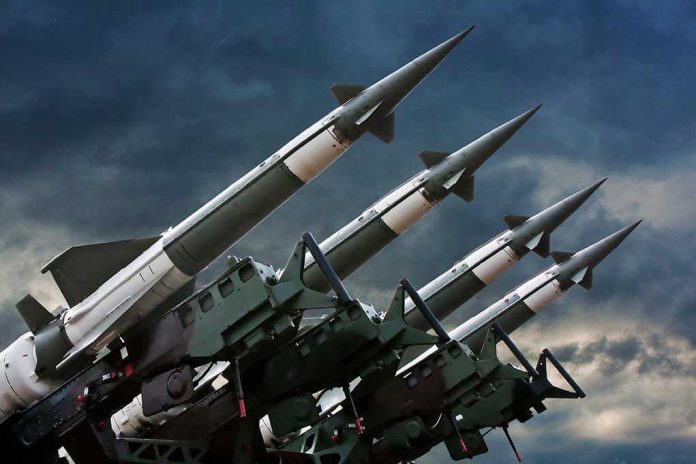
NATO’s much-hyped spending spree on air defense may make headlines, but money won’t buy the West a miracle cure after decades of neglect and political denial.
At a Glance
- NATO members pledge to hike defense budgets to 5% of GDP by 2035, with air defense as the new obsession.
- Production bottlenecks, workforce shortages, and years of industrial atrophy mean new missiles won’t arrive overnight.
- Alliance-wide coordination and standardization remain as elusive as ever, threatening to turn good intentions into wasted billions.
- Russia’s relentless missile and drone attacks on Ukraine exposed NATO’s glaring vulnerabilities, finally forcing European leaders out of their comfort zones.
West Scrambles to Play Catch-up as Russian Missiles Expose Decades of Complacency
Russia’s 2022 invasion of Ukraine was a wake-up call the Western alliance could no longer snooze through. While Moscow’s barrage of missiles and drones rained down on Ukrainian cities, NATO capitals suddenly realized that the “peace dividend” era was over—and that their air defenses were embarrassingly hollow. The NATO brain trust, having spent the last thirty years fixated on counterterrorism and nation-building boondoggles in places like Afghanistan and Iraq, had quietly let missile defense stocks dwindle and production lines rust. Now, as Russian forces re-arm and Ukraine pleads for help, European leaders and Pentagon officials are frantically trying to plug a gaping hole in the continent’s security architecture. But let’s be honest: after years of political dithering and virtue-signaling, did anyone really expect the West’s defense industry to spring instantly into action?
With Sweden and Finland now in the NATO club and frontline states from Poland to the Baltics demanding real protection, the alliance is pledging to pour cash into air defense—promising a fivefold increase in capacity by 2035. But as the usual cast of defense contractors—Lockheed Martin, Raytheon, Rheinmetall—line up for contracts, the inconvenient truth is that you can’t buy your way out of an industrial deep freeze. The experts are blunt: the backlog for new missiles stretches seven years, and the skilled workforce needed to build them doesn’t appear with a snap of the fingers, no matter how much taxpayer money you fling at the problem.
Money Can’t Buy Manufacturing Muscle or Common Sense
The NATO summit may have been all smiles and flag-waving, but behind the scenes, the alliance is struggling to turn grandiose spending promises into tangible results. Sure, Lockheed Martin has ramped up PAC-3 missile production to 500 units a year, and European firms are scrambling to build a new missile hub. But full-scale production won’t kick in until 2027 at the earliest. Meanwhile, order backlogs for systems like MBDA’s anti-air missiles are measured in years, not months. The industry’s atrophy didn’t happen overnight, and neither will its recovery. As one defense analyst put it, “You can sign all the contracts you want, but the production capability is lacking.” Translation: European politicians may love to pose with big checks, but the real world moves at the speed of skilled labor and functioning supply chains.
Even if every factory fired on all cylinders, NATO’s real challenge is coordination—a word that makes bureaucrats break out in hives. Each member state jealously guards its own procurement fiefdom, resulting in a hodgepodge of incompatible systems. The Nordic and Baltic states are trying to show the way with a combined air operations center in Norway, but alliance-wide standardization remains a fantasy. As another expert noted, “Culture takes far more time to change than just buying hardware.” That’s bureaucrat-speak for “We’ll keep duplicating efforts and burning cash.” If only the West approached military readiness with the same zeal as they do virtue-signaling at climate conferences or writing checks to international NGOs, maybe we’d have a fighting chance.
The Clock Is Ticking—And the Bill Is Coming Due
The short-term impact of NATO’s air defense revival will be a boost for the defense industry and, hopefully, incremental improvements for frontline allies. But the real payoff—robust, integrated missile shields—remains years away. In the meantime, Russia isn’t waiting for Western bureaucrats to get their act together. The Kremlin’s daily missile and drone attacks on Ukraine are a not-so-subtle reminder of what’s at stake. NATO’s Secretary General warns that “we must be able to defend ourselves from such attacks,” but the gap between NATO’s defenses and the Russian threat is, in the words of one expert, “about eight” on a scale of one to ten. Translation: the West is still playing catch-up, and the bill for decades of delusion is coming due.
What’s most galling to anyone with common sense is that this entire scramble could have been avoided if Western leaders had prioritized the basics of defense and sovereignty instead of chasing utopian dreams and endless social engineering projects. Instead, we’re left with a continent that can barely protect its own skies, while taxpayers foot the bill for the political class’s mistakes. If NATO wants to be more than a talking shop, it’ll need more than money and press releases—it’ll need a return to real-world priorities and the guts to fix what’s broken. Until then, the West’s air defense “revitalization” is long on promises, short on results, and a painful lesson in what happens when you ignore the obvious for too long.
Sources:
Business Insider – NATO’s Air Defense Shortfall
Breaking Defense – European Industry Scrambles
Financial Times – NATO’s Air Defense Gaps









